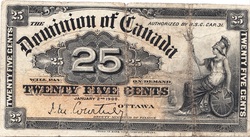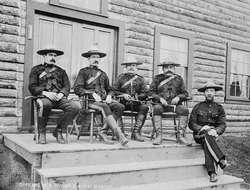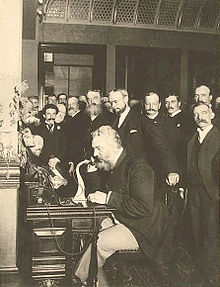
Government
The Canadian government at the turn of the 20th century mainly had one Prime Minister; Wilfred Laurier of the Liberal Party from 1896-1911. When he was elected, the Liberals ended the Conservative control over Parliament since Sir John A. Macdonald. The Liberals would then continue to win elections throughout most of the century. This was also the time period when there was a huge economic growth turn and industries thrived. Our government continued to settle the West, build more railways, and develop larger industries.
The Canadian government at the turn of the 20th century mainly had one Prime Minister; Wilfred Laurier of the Liberal Party from 1896-1911. When he was elected, the Liberals ended the Conservative control over Parliament since Sir John A. Macdonald. The Liberals would then continue to win elections throughout most of the century. This was also the time period when there was a huge economic growth turn and industries thrived. Our government continued to settle the West, build more railways, and develop larger industries.

Immigration
To help populate Canada and especially the West (Alberta, Saskatchewan, British Columbia and Manitoba), Non-French and non-British immigrants were encouraged to immigrate to Canada with the promise of free or cheap land. Canada also allowed as many immigrants as possible to settle here but they did tax people coming in from Asia and Africa because Canadians did not believe that they were fit for a farming lifestyle. Canada also attracted immigrants by establishing emigration offices in several other countries. This lead Canada to become more of a multicultural nation comprised of mostly Europeans such as Germans, Scandinavians, Hungarians, Ukrainians, Polish and Italians.
To help populate Canada and especially the West (Alberta, Saskatchewan, British Columbia and Manitoba), Non-French and non-British immigrants were encouraged to immigrate to Canada with the promise of free or cheap land. Canada also allowed as many immigrants as possible to settle here but they did tax people coming in from Asia and Africa because Canadians did not believe that they were fit for a farming lifestyle. Canada also attracted immigrants by establishing emigration offices in several other countries. This lead Canada to become more of a multicultural nation comprised of mostly Europeans such as Germans, Scandinavians, Hungarians, Ukrainians, Polish and Italians.

Social Customs
Our society was slowly adapting to women’s rights but women still didn’t have the right to vote, they were considered “lower ranked” compared to men, and it was unacceptable for women to do things that men did, like work in the government. Our social customs were mainly influenced by British customs in the English society and were influenced by the French customs back in Europe. There were also different customs in the Native American culture. Customs were getting more diverse as immigration flourished and we became a multicultural country.
Our society was slowly adapting to women’s rights but women still didn’t have the right to vote, they were considered “lower ranked” compared to men, and it was unacceptable for women to do things that men did, like work in the government. Our social customs were mainly influenced by British customs in the English society and were influenced by the French customs back in Europe. There were also different customs in the Native American culture. Customs were getting more diverse as immigration flourished and we became a multicultural country.

Technology
This was the time period when things we use in our everyday lives were just invented. Technology was growing to keep up with the industrial revolution and factories were getting modernized. The look of the city was changing as cars were being mass produced and roads were paved. Gillette made their first razor in 1901, radio receivers were developed, the air conditioner was made, the polygraph was invented, the Wright Brothers invented the first manned airplane, and windshield wipers were made. Tractors were invented and made a huge impact on agriculture. Electricity was being used more commonly and we produced hydro. The use of the modern day telephone was just being introduced into homes at the start of the century. Technology in the armed forces was getting more advanced and our military gained an array of war machines and became a major military force.
This was the time period when things we use in our everyday lives were just invented. Technology was growing to keep up with the industrial revolution and factories were getting modernized. The look of the city was changing as cars were being mass produced and roads were paved. Gillette made their first razor in 1901, radio receivers were developed, the air conditioner was made, the polygraph was invented, the Wright Brothers invented the first manned airplane, and windshield wipers were made. Tractors were invented and made a huge impact on agriculture. Electricity was being used more commonly and we produced hydro. The use of the modern day telephone was just being introduced into homes at the start of the century. Technology in the armed forces was getting more advanced and our military gained an array of war machines and became a major military force.
Fashion
Canada usually had fashions which were related to Britain. The style trend for men those days was a tall, athletic look. Men’s trousers were usually in a straight leg cut and suits were tailored fairly loose. Top hats were a common accessory even in the lower classes but were a requirement for upper class men and was a symbol of wealth a high social status. Men wore boots, oxfords, and even pumps. Pumps were in style for young, rich men when they were dancing and were the proper shoes to wear for formal events. Women were dressed very conservatively and that was tradition. Women’s fashions adapted to the fact that women were now working outside the home more often so big, poufy skirts were replaced by smaller skirts and even trousers. Collars were tall and helped elongate the body. Sportswear was also becoming popular as society changed their view on what women could do. They would wear specially designed dresses for things such as cycling and tennis. Children usually had no say in their clothing and the wealthier children would play in their formal clothing. Everyone wore dresses, even boys wore them when they were toddlers. A decade into the 20th century, people started realizing that it was more practical to wear rompers and playsuits for play. Nonetheless, style is always evolving.
Canada usually had fashions which were related to Britain. The style trend for men those days was a tall, athletic look. Men’s trousers were usually in a straight leg cut and suits were tailored fairly loose. Top hats were a common accessory even in the lower classes but were a requirement for upper class men and was a symbol of wealth a high social status. Men wore boots, oxfords, and even pumps. Pumps were in style for young, rich men when they were dancing and were the proper shoes to wear for formal events. Women were dressed very conservatively and that was tradition. Women’s fashions adapted to the fact that women were now working outside the home more often so big, poufy skirts were replaced by smaller skirts and even trousers. Collars were tall and helped elongate the body. Sportswear was also becoming popular as society changed their view on what women could do. They would wear specially designed dresses for things such as cycling and tennis. Children usually had no say in their clothing and the wealthier children would play in their formal clothing. Everyone wore dresses, even boys wore them when they were toddlers. A decade into the 20th century, people started realizing that it was more practical to wear rompers and playsuits for play. Nonetheless, style is always evolving.
 RSS Feed
RSS Feed